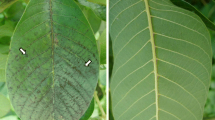Summary
Four fruticose lichens of different genera, all belonging to the cyanolichen familyLichinaceae were studied by ultrathin sectioning and freeze-fracturing/-etching in order to see details in the structure of the photobiont-mycobiont interface. Within the haustorial region, the fibrillar sheath of the photobiont was almost absent and the thickness of the fungal cell wall was strongly reduced.
The wavy outline of the cytoplasmic membrane in haustorial cells, which is so obvious in ultrathin sections, was found to be an artifact,i.e., originating during specimen preparation, it was not found in freeze-fractured samples.
Invaginations of the fungal cytoplasmic membrane that were 25–125nm in width and 50–800 nm in length occurred in ultrathin sections and freeze-fractured samples. The invaginations were located within the cytoplasmic membrane of haustorial and non-haustorial cells.
No differences between freshly collected and rewetted dry herbarium specimens could be detected by means of transmission electron microscopy.
Similar content being viewed by others
References
Ahmadjian V (1982) Algal/fungal symbioses. In:Round, Chapman (eds) Progress in phycological research, vol 1. Elsevier Biomedical Press BV, pp 179–233
Aldrich HC, Mollenhauer HH (1986) Secrets of successful embedding, sectioning, and imaging. In:Aldrich HC, Todd WJ (eds) Ultrastructure techniques for microorganisms, chapter 4. Plenum Press, New York London, pp 101–132
Allen JV, Hess WM, Weber DJ (1971) Ultrastructural investigations of dormantTilletia caries teliospores. Mycologia 63: 144–156
Ascaso C, Galvan J (1976) The ultrastructure of the symbionts ofRhizocarpon geographicum, Parmelia conspersa andUmbilicaria pustulata growing under dryness conditions. Protoplasma 87: 409–18
—,Brown DH, Rapsch S (1985) Ultrastructural studies of desiccated lichens. In:Brown DH (ed) Lichen physiology and cell biology. Plenum Press, New York London, pp 259–274
Boissière MC (1982) Cytochemical ultrastructure ofPeltigera canina: some features related to its symbiosis. Lichenologist 14: 1–27
Brunner U (1985) Ultrastrukturelle und chemische Zellwanduntersuchungen an Flechtenphycobionten aus 7 Gattungen derChlorophyceae (Chlorophytina) unter besonderer Berücksichtigung sporopollenin-ähnlicher Biopolymere. Juris Druck und Verlag, Zürich, pp 1–143
Büdel B (1985) Blue-green phycobionts in the liehen familyLichinaceae. Arch Hydrobiol [Suppl] 71. (Algological Studies 38/39): 355–357
—,Rhiel E (1985) A new cell wall structure in a symbiotic and free-living strain of the blue-green alga genusChroococcidiopsis (Pleurocapsales). Arch Microbiol 143: 117–121
Clarke KJ, Leeson EA (1985) Plasmalemma structure in freezing tolerant unicellular algae. Protoplasma 129: 120–126
Collins CR, Farrar JF (1978) Structural resistances to mass transfer in the lichenXanthorina parietina. New Phytol 81: 71–83
Drews G, Weckesser J (1982) Function, structure and composition of cell walls and external layers. Blackwell Scientific Publications, Oxford London Edinburgh Boston Melbourne. Botanical Monographs, vol 19, pp 333–357
Griffiths DA (1971a) The fine structure of basidiospores ofPanaeolus campanulatus (L.) Fr. revealed by freeze etching. Arch Microbiol 76: 74–82
— (1971b) Hyphal structure inFusarium oxysporum (Schlecht) revealed by freeze etching. Arch Microbiol 79: 93–101
Henssen A (1963) Eine Revision der FlechtenfamilienLichinaceae andEphebaceae. Symb Bot Upsal 18: 1–123
Honegger R (1982a) Cytological aspects of the triple symbiosis inPeltigera aphthosa. J Hattori bot Lab 52: 379–391
— (1982b) Ascus structure and function, ascospore delimitation and phycobiont cell wall types associated with theLecanorales (lichenized ascomycetes). J Hattori bot Lab 52: 417–429
— (1984) Cytological aspects of the mycobiont-phycobiont relationship in lichens. Lichenologist 16: 111–127
— (1985) Fine structure of different types of symbiotic relationships in lichens. In:Brown DH (ed) Lichen physiology and cell biology. Plenum Press, New York London, pp 287–302
— (1986) Ultrastructural studies in lichens. I. Haustorial types and their frequences in a range of lichens with trebouxioid photobionts. New Phytol 103: 785–795
Jacobs JB, Ahmadjian V (1971a) The ultrastructure of lichens. II.Cladonia cristatella: the lichen and its isolated symbionts. J Phycol 7: 71
— — (1971b) The ultrastructure of lichens. IV. Movement of carbon products from alga to fungus as demonstrated by high resolution radioautography. New Phytol 70: 47–50
— — (1973) The ultrastructure of lichens. V.Hydrothyria venosa, a freshwater lichen. New Phytol 72: 155–160
Littlefield LJ, Bracker CE (1972) Ultrastructural specialization at the host-pathogen interface in rust-infected flax. Protoplasma 74: 271–305
Miller KR, Cushman RA (1979) A chloroplast membrane lacking photosystem II. Thylakoid stacking in the absence of the photosystem II particle. Biochim Biophys Acta 546: 481–497
Moor H, Mühlethaler K (1963) Fine structure of frozen etched yeast cells. J Cell Biol 17: 609–628
Oh JK, Hess WM (1982) Unidentified organelles and vacuoles inTilletia teliospores. Mycologia 74: 1032–1037
Paran N, Ben-Shaul Y, Galun M (1971) Fine structure of the blue-green phycobiont and its relationship to the mycobiont in twoGonohymenia lichens. Arch Microbiol 76: 103–113
Peat A (1968) Fine structure of the vegetative thallus of the lichen,Peltigera polydactyla. Arch Microbiol 61: 212–222
Peveling E (1968) Oberflächenvergrößerung des Plasmalemmas in symbiotisch lebenen Pilzen. Naturwissenschaften 55: 451
— (1969) Elektronenoptische Untersuchungen an Flechten. IV. Die Feinstruktur einiger Flechten mit Cyanophyceen-Phycobionten. Protoplasma 68: 209–222
— (1973) Vesicles in the phycobiont sheath as possible transfer structures between the symbionts in the lichenLichina pygmaea. New Phytol 72: 343–345
Reynolds ES (1963) The use of lead citrate at high pH as an electron opaque stain in electron microscopy. J Cell Biol 17: 208–212
Sleytr UB, Silva MT, Kocur M, Lewis NF (1976) The fine structure ofMicrococcus radiophilus andMicrococcus proteolyticus. Arch Microbiol 107: 313–320
Spurr AR (1969) A low viscosity epoxy resin embedding medium for electron microscopy. J Ultrastruct Res 26: 31–43
Watson ML (1958) Staining of tissue sections for electron microscopy with heavy metals. J Biophys Biochem Cytol 4: 475–478
Author information
Authors and Affiliations
Rights and permissions
About this article
Cite this article
Büdel, B., Rhiel, E. Studies on the ultrastructure of some cyanolichen haustoria. Protoplasma 139, 145–152 (1987). https://doi.org/10.1007/BF01282285
Received:
Accepted:
Issue Date:
DOI: https://doi.org/10.1007/BF01282285




